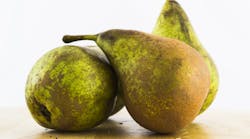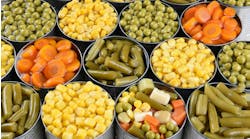When Ben Colvin, president of Devil's Foot Beverage Co., seeks the ingredients he uses in the company's non-alcoholic sparkling beverages, he doesn't turn to traditional suppliers. Rather, he usually finds material that is headed to the dump—pomace left over from apple juice pressing, blemished peaches from a university's research fields or “ugly” fruit from local orchards.
In other words, Devil's Foot is “upcycling” food that might otherwise have been landfilled.
“I came out of the conservation world where I worked on protecting wild places and wild things from the Southeastern U.S. to Uganda and Peru—and built into our business model the intention to feature sustainable practices,” Colvin says. “In particular, using ‘ugly fruit,’ local/regional small farmer produce and incorporating the whole goodness of fruits used in our products.”
Trending, but not new
Upcycled food is enjoying a surge in popularity, says Turner Wyatt, CEO of the Upcycled Foods Assn. This trade group, which started two years ago and has 185 members, tracks media interest in upcycled food and has seen it climb 128% over the past year. And members’ sales are climbing even faster, Wyatt reports.
“Our members are projecting sales increases upwards of 160% this year over last year,” he says.
But the basic concept of upcycling food byproducts is not particularly new. Tons of byproducts of food manufacturing have long made their way into other products. Food processors simply didn’t market that fact.
“I think to some extent it’s always been around -- without that approach we wouldn’t have sausages and hot dogs and stocks and pet food,” notes Jonathan Deutsch, a professor and director of the Food Lab at Drexel University.
“I think what’s new and different is that when I was coming up in the food industry in the 1990s, it was a little bit of an industry secret. You didn’t want to highlight that on your plant tour. The conventional wisdom was really that consumers would not accept this and would be shocked and appalled if they knew about upcycling.”
That mindset has changed, Deutsch says. Today many consumers are pleased to support the concept of finding new uses for food that otherwise would have gone to waste. And their appreciation of the nutrition value of many upcycled foods also has grown.
Furthermore, recent changes in the scale and types of food production have increased the quantity of byproduct available for upcycling.
“Take tofu making for example,” Deutsch says. “Okara (soybean pulp left over from tofu or soy milk production) traditionally might have been used in a side dish or as a staff meal, but now that we have giant plant-based milk factories making thousands of gallons of soy milk, there has not been a good supply chain for that. So that’s what’s changing – due to scaling in the food industry, there’s more opportunity for upscaling.”
Supply concerns?
A commercial food processor accustomed to placing an order with an industrial-scale ingredient supplier and having a pallet delivered the next day or two may fear that finding a consistent supply of upcycled ingredients is daunting. That may be one reason that most companies pioneering upcycled food processing are smaller and more nimble.
“We have enough momentum that people are proactively reaching out to us directly, and in turn, when we contact potential sources they are familiar with our brand,” Burke says. “But the work is never done in building out this ecosystem of suppliers and figuring out efficiencies and logistics around inbound supply and outbound product.”
Similarly, Colvin reports that he is always looking for additional sources for upcycled ingredients for his canned sodas. But he embraces that challenge.
“I think we would worry a little about the supply being sufficient, except that we are a ‘craft farm-to-can brewery’ that can be nimble, so we can a ton or just a little,” Colvin says. “Also, most of this type of ‘waste’ product is perfectly fine to be captured quick enough after pressing and stored up in freezers for future use.”
However, as the upcycled food industry grows, some companies are developing businesses creating a consistent supply of ingredients.
For example, Renewal Mill has developed a model that involves installing processing equipment inside the manufacturing facilities of its partners. That allows them to capture and process the byproducts immediately, creating a more consistent supply.
Renewal Mill, founded in 2016, currently supplies Organic Okara Flour, Oat Protein Flour and high-protein sunflower meal in 25-lb. bags to food processors and bakeries. More commercial-scale ingredients are on their way.
“Renewal Mill aims to be the go-to upcycled ingredients supplier for the food industry and is quickly adding new upcycled ingredients to our portfolio, like protein powders made from the nut and seed cakes left over from cold-pressed oil processing,” Cotto says.
Agricycle Global is another ingredient supplier using upcycled source material. For example, the company’s Field Better Foods brand – launched this year—offers a wide range of flours made from produce, grains, legumes and pulses from a network of small farms in Africa. These agricultural products otherwise would not have made it to market, says Valeria Landazuri, a company spokesperson.
True Made Foods uses carrot and butternut squash puree created from “ugly” produce to sweeten their ketchup and barbecue sauces. But the company does not source the unsellable produce themselves – they buy it from YAMCO, a farmer cooperative.
“One of YAMCO’s strategic advantages is that they have a patented aseptic packaging process, which keeps the purees shelf stable and in good condition for months,” says Abraham Kamarck, CEO and founder of True Made Foods. “There is always some variability of supply depending on harvests and there have been some shortages, but nothing major.”
A few major food manufacturers have embraced the upcycling trend. Dole Sunshine Co., for example, converted nearly 10,000 tons of imperfect bananas into Banana Dippers frozen treats in 2020, according to a spokesperson. But most players in the field are smaller; as more major food manufacturers start regularly buying upcycled ingredients, companies making those ingredients will have the incentive to increase supply, Deutsch notes.
“You have a chicken-or-the-egg scenario,” he says. “Right now you have a lot of start-up companies in the space, but the major companies are saying, ‘I’m not sure we’ll have a dependable supply on this ingredient.’ So supply and demand needs to work in concert to have some large scale impact.”
Quality control
The quality of upcycled ingredients may also be a concern for food processors. After all, the food was headed to the landfill – how could it be good? There are actually two parts to this situation: the state of the upcycled ingredient in the first place, and the maintenance of freshness as the ingredient moves through the supply chain.
Deutsch says the first point – how good is the ingredient to begin with – should not be a concern.
“In some ways the upcycled product has already been through the QA process,” Deutsch says. “And then you’re doing a second round of QA at the upcycling level.”
Furthermore, sometimes the nutritional value of the byproduct is higher than that of the original processed food. For example, the byproduct of juice making – fruit pulp – contains more fiber and nutrients than the fruit juice the original food processor is selling, Deutsch says. And imperfect produce, though it’s not as pretty as store-bound produce, has the same nutritional value and may even taste better.
“Ugly fruit usually comes from organic or no-spray small farms and tastes way better than polished looking fruit you find on the shelf,” Colvin claims.
Where quality control may become a concern is if a perishable byproduct, such as fruit pulp, is not immediately put into a controlled environment. If the cold chain is broken because the original food manufacturer is treating the byproduct as waste, it won’t last long. Consequently, tapping the value of byproducts requires a change in the flow at the original manufacturer, Deutsch asserts.
“Typically in a plant the food comes in dirty, it’s washed, it’s processed, the cold chain is maintained, and then it goes to customers,” Deutsch says. “At the same time there’s a co-stream of scraps where the cold chain is not maintained, and it goes to the dumpster. With upcycling you’re taking the flow and challenging it. How do we maintain cold chain on something that used to sit on the loading dock until the trash truck shows up? Those are challenges a company needs to think through.”
That challenge has been addressed by companies like Renewal Mill, which puts its equipment directly into the flow. Another company doing something similar is Regrained, founded in 2012.
“Regrained works with spent grain from beer brewing,” Wyatt says. “They have technology that takes the spent grain to a nearby facility and processes it in a matter of minutes…so it can be safe to handle and more stable.”
Convincing consumers
An essential part of the success of upcycled food is getting consumers to buy it. That’s a complicated task that involves creating a message that upcycled food is good for you and helps the environment, Deutsch believes.
“If I say to you, ‘I have two cookie options for you – one regular cookie and one upcycled cookie – you’ll probably say, ‘I’ll take the regular cookie,’” he says. “But If I say, ‘Here’s a cookie that’s better for the environment and is nutrient dense, you’re much more likely to buy the upcycled cookie. The challenge with that example is I spent more time explaining it to you than the typical consumer will spend throwing something into the cart.”
The Upcycled Food Assn. is addressing that situation through its Upcycled Certified program. The program, launched this past summer, uses a third-party certifying body to ensure that a product includes ingredients that help prevent food waste. Companies that get the certification can put the Upcycled Certified logo on their packaging, and Wyatt says the association’s research shows that the logo increases the “intent to buy” for a product for more than half of the people surveyed.
However, even if the association succeeds in convincing consumers that upcycled food is fantastic, those products won’t move off the shelves if the price is too high. Consumers tend to think using upcycled ingredients saves the manufacturer money – they’re making food from waste, right? – but that’s often not the case.
“Right now what we’re seeing is a lot of the products are more expensive,” Wyatt says. “There’s not these really well buttoned-up supply chains in place yet for the prices to come down.”
Upcycling holds promise in this era of growing environmental concern, but the issues facing the concept – consistent supply, quality control and consumer acceptance – will not be fully addressed until more major players join the game, Deutsch says: “Until our colleagues in the industry are aware of upcycling, have thought about it, and made a decision if it’s right for their company, we’re not going to get as far as we need to in this field.”


